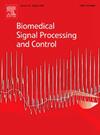用随机微分方程检测IV级胶质瘤中异柠檬酸脱氢酶突变状态
IF 4.9
2区 医学
Q1 ENGINEERING, BIOMEDICAL
引用次数: 0
摘要
异柠檬酸脱氢酶(IDH)突变的状态是决定胶质瘤治疗方案的关键,特别是在IV级肿瘤中。目前确定这种状态的金标准依赖于侵入性程序,如活检或手术,这与风险和高成本有关。本研究提出了一种创新的、非侵入性的方法,用于使用常规MRI图像识别IV级胶质瘤中的IDH突变状态。这种方法利用了基于随机微分方程(SDE)的统计建模框架。鉴于MRI图像表现出固有的随机和非平稳特性,它们可以有效地建模为随机过程。在该方法中,将分数阶拉普拉斯算子应用于MRI图像,使像素强度在统计上独立,并产生零均值α稳定分布。该分布的参数以及其他特征被用作四个分类器的输入:支持向量机、k近邻、随机森林和极端梯度增强,它们自动检测IDH突变状态。结果表明,第一个数据集的分类准确率为99.29%,灵敏度为99.06%,特异性为99.52%,受试者工作特征曲线下面积(AUC)为100%;第二个数据集的分类准确率为97.60%,灵敏度为97.14%,特异性为97.92%,AUC为99%。另一方面,基于患者的方法在第一和第二数据集上分别达到了91.67%和83.33%的准确率。这些结果强调了该方法在IV级胶质瘤中检测IDH突变状态的显著有效性。本文章由计算机程序翻译,如有差异,请以英文原文为准。
Detecting isocitrate dehydrogenase mutation status in grade IV gliomas using stochastic differential equations
The status of the Isocitrate Dehydrogenase (IDH) mutation is crucial in determining the treatment plan for gliomas, particularly in grade IV tumors. The current gold standard for identifying this status relies on invasive procedures, such as biopsy or surgery, which are associated with risks and high costs. This study proposes an innovative, non-invasive method for identifying IDH mutation status in grade IV gliomas using conventional MRI images. This approach leverages a statistical modeling framework based on stochastic differential equations (SDE). Given that MRI images exhibit inherent stochastic and non-stationary properties, they can be effectively modeled as stochastic processes. In the proposed method, a fractional Laplacian operator is applied to MRI images, rendering the pixel intensities statistically independent and resulting in a zero-mean alpha-stable distribution. The parameters of this distribution, along with additional features, are used as input for four classifiers: Support Vector Machine, K-Nearest Neighbor, Random Forest, and Extreme Gradient Boosting, which automatically detect the IDH mutation status. The results revealed a classification accuracy of 99.29%, sensitivity of 99.06%, specificity of 99.52%, and an area under the receiver operating characteristic curve (AUC) of 100% for the first dataset, and an accuracy of 97.60%, sensitivity of 97.14%, specificity of 97.92%, and AUC of 99% for the second dataset in the slice-wise approach. On the other hand, the patient-wise approach achieved accuracies of 91.67% and 83.33% for the first and second datasets, respectively. These outcomes underscore the remarkable effectiveness of the proposed approach in detecting IDH mutation status in grade IV gliomas.
求助全文
通过发布文献求助,成功后即可免费获取论文全文。
去求助
来源期刊

Biomedical Signal Processing and Control
工程技术-工程:生物医学
CiteScore
9.80
自引率
13.70%
发文量
822
审稿时长
4 months
期刊介绍:
Biomedical Signal Processing and Control aims to provide a cross-disciplinary international forum for the interchange of information on research in the measurement and analysis of signals and images in clinical medicine and the biological sciences. Emphasis is placed on contributions dealing with the practical, applications-led research on the use of methods and devices in clinical diagnosis, patient monitoring and management.
Biomedical Signal Processing and Control reflects the main areas in which these methods are being used and developed at the interface of both engineering and clinical science. The scope of the journal is defined to include relevant review papers, technical notes, short communications and letters. Tutorial papers and special issues will also be published.
 求助内容:
求助内容: 应助结果提醒方式:
应助结果提醒方式:


